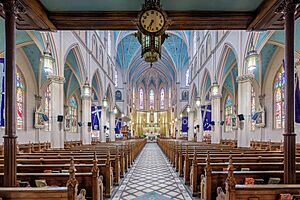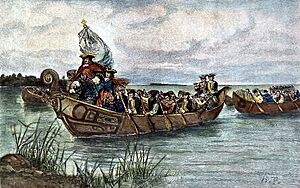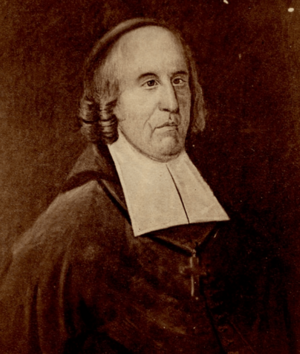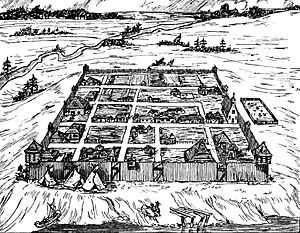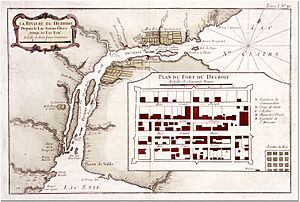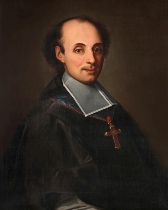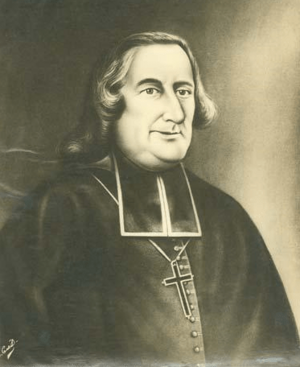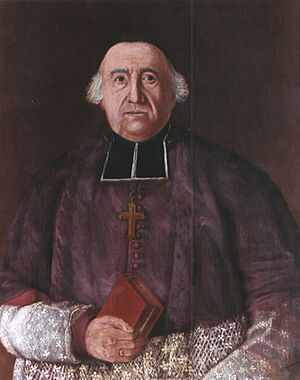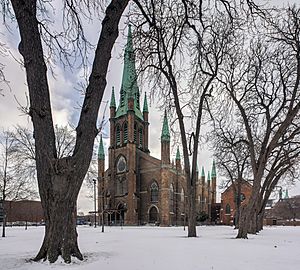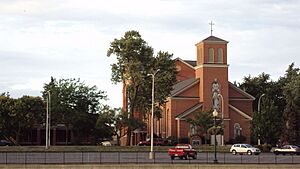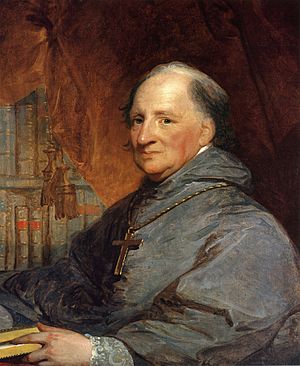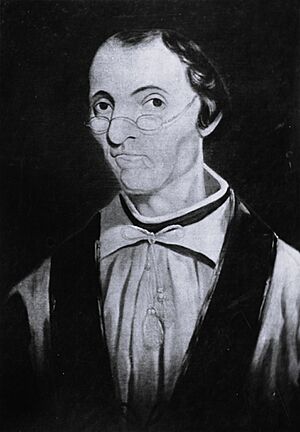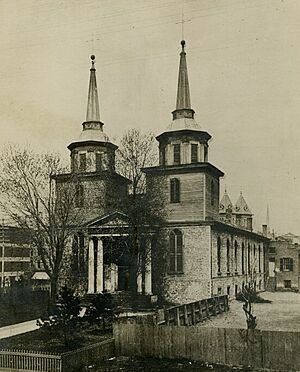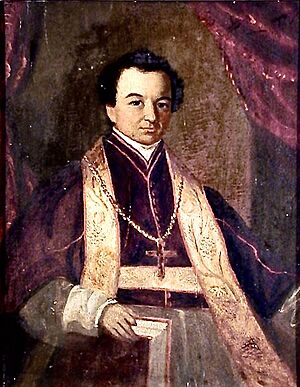Basilica of Sainte Anne de Détroit facts for kids
Quick facts for kids Basilica of Sainte Anne de DétroitBasilique Sainte-Anne-de-Détroit |
|
|---|---|
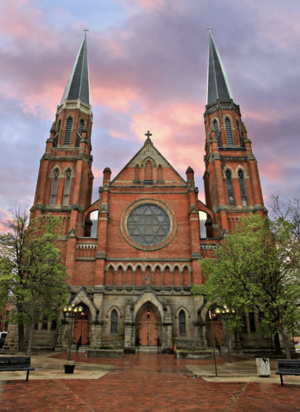
Ste. Anne de Détroit
|
|
| 42°19′15″N 83°04′36″W / 42.32083°N 83.07667°W | |
| Location | Detroit, Michigan |
| Country | United States |
| Denomination | Catholic Church |
| Tradition | Roman Rite |
| History | |
| Status |
|
| Dedication | St. Anne |
| Dedicated | December 6, 1891 |
| Consecrated | October 30, 1887 |
| Architecture | |
| Architect(s) | Albert E. French |
| Style | Classical Revival Late Gothic Revival |
| Administration | |
| Archdiocese | Detroit |
The Basilica of Sainte Anne de Détroit (also known as Basilique Sainte-Anne-de-Détroit in French) is a historic church in Detroit, Michigan. It is located at 1000 St. Anne Street. The church serves the Ste. Anne Parish, which was started by Antoine de la Mothe Cadillac and 100 French colonists on July 26, 1701. This makes it the second-oldest continuously running Roman Catholic parish in the United States. The beautiful Gothic Revival style church was designed by Albert E. French.
The basilica became nationally famous when it was added to the National Register of Historic Places in 1976. It was also named a Michigan Historical Site in 1975. In a special honor, Pope Francis named the church a minor basilica on March 1, 2020. This made it the 86th minor basilica in the United States and the third in Michigan.
The main entrance opens onto a tree-lined plaza with brick paving. The church has flying buttresses and four gargoyles guarding its main entrance. Inside, you can see the oldest stained glass in the City of Detroit.
A small chapel next to the basilica holds important relics. The main altar from the 1818 stone church is there, along with the tomb of Father Gabriel Richard. Other old items from the 1818 church include a fancy communion rail, a statue of Ste. Anne, and the Beaubien Bell.
On July 16, 2025, a group called The Catholic Initiative took over ownership of the basilica. This nonprofit group works to restore and protect the church.
Parish History: A Journey Through Time
The Early Years: 18th Century Beginnings
On June 5, 1701, a group of 25 canoes left Montreal, Quebec. They carried 50 soldiers, 50 skilled workers, 2 priests, and an explorer, Antoine de la Mothe Cadillac. They traveled along rivers and lakes, finally reaching the Detroit River on July 24, 1701. They landed at a steep bluff where Hart Plaza is today. There, they began building Fort Pontchartrain du Detroit.
One of the first buildings they put up was a chapel. It is believed to have been built on July 26, 1701, which is the feast day of Saint Anne. Saint Anne was very important to them, and they chose her as their special protector. Because of her, the first street in the outpost was named "Ste. Anne Street" until 1805. Churches continued to be built in this area, just west of where Jefferson and Griswold Streets are now.
Two priests came with Cadillac. Father François Vaillant de Gueslis wanted to work with the native people. But because of problems between Cadillac and the Jesuits, he went back to Montreal. Father Constantin de L'Halle stayed and became the only chaplain.
On October 5, 1703, a terrible fire started by native people swept through the fort. It destroyed the church, the priest's house, and other buildings. Strong winds made the fire worse, and the church's important records were lost. A new record book started on February 2, 1704, with the baptism of Marie Therese, Cadillac's daughter. This began a continuous record of church events.
Father De L'Halle worked hard, but the church was very poor. The rebuilt church lacked even basic things. Cadillac asked his boss for money to help the parish.
Also, one priest was not enough to teach the many native people, mainly the Ottawa, Wyandot, and Miami tribes. These tribes often fought. In 1706, a fight between the Miami and Ottawa tribes led to Father De L'Halle's death. After he died, Cadillac returned from Quebec with Father Dominique de la Marche. Father De la Marche was supposed to work only with the natives, but he became the pastor after Father De L'Halle's sudden death.
To help with missionary work, Father Cherubin Deniau arrived in 1707. A year later, as a more solid church was being built, Father De la Marche left for Quebec, and Father Deniau became the pastor. At this time, 63 French families lived in homes made of stakes, mud, and thatch.
Father Deniau was good at his missionary work. An inventory of his belongings from August 25, 1711, described the church: "Also a building, used as a church, 23 feet long, 24 1/2 feet wide, 10 high; boarded entirely above, with oak joists in a good ridge, and below of beams with square joints; with doors, window and shutters, and sash frames between of twenty squares each; the whole closing with a key. Also a heavy bell." The church had a green carpet and a walnut-wood altar. Above the altar was a small copper or brass crucifix that could turn to show a silver monstrance. The altar was decorated with painted wooden candlesticks and artificial flowers. Two small tables and a gilded picture of the Blessed Virgin Mary were also there. A simple tin lamp hung from the ceiling. Unlike other buildings in the fort, the church was built with logs "laid one on the other."
In 1714, as Father Deniau's time ended, the church was sadly destroyed. Charles Regnault, Sieur Dubuisson, became the fort's commander. He was not as strong a leader as Cadillac, especially with the native tribes. As English influence grew, threatening the French outpost, Dubuisson decided to make the fort smaller. This left the church outside the fort's walls, making it easy to destroy.
The Fox Indians were a threat to the fort. To protect the fort, the defenders decided to sacrifice the church. They removed the protective fences around the church, and it was torn down. This was because the church could have given cover to attackers. For several years after, church services were held in a temporary chapel inside one of the larger fort buildings.
Between 1715 and 1718, Father Hyacinthe Pelfresne was the pastor. Father Antoine Delino followed him until 1722. Then, Father Bonaventure Lienard became pastor and stayed until 1754. His time was important because the parish's official status changed. Unlike earlier priests who signed as "chaplains," Lienard began signing as "pastor." This showed a more formal church structure. Father Lienard started plans for a permanent church, which was finished in 1723. Father De L'Halle's remains were reburied there.
The parish used an old French system called "La Fabrique" to manage its money. This system had the pastor and three laymen, called "marguilliers" or churchwardens. They collected money, paid debts, and kept funds safe in a locked box. New wardens were chosen each year. These wardens were important and had special seats in the church. They also played big roles in church parades.
The church got money from collections, fees for weddings and funerals, and pew rent. The pastor's money came from tithes (a small part of the grain harvest) and the Christmas collection. During Christmas, the pastor would visit each home, and a warden would collect donations. The "fabrique" only handled church money and property. Spiritual matters were handled by tradition, church law, and the pastor, with the bishop's approval.
Early Detroiters went to Mass often: every Sunday and on 34 special holy days. In 1744, the bishop reduced this to 15. Sunday was a day for worship and for people to meet and share news. Detroit's growth slowed down for a while, and the government even thought about leaving the settlement. But as the English became more present, the French became interested again. Sadly, there were still problems between the settlers and the fort commanders, mostly about trading. Father Lienard often had to act as a peacemaker.
In 1730, New France realized the fort was important if there were wars with England. To help it grow, they offered rewards to families and soldiers who would settle near the fort. People were encouraged to move there with good offers. New settlers after 1749 received land on both sides of the Detroit River. This helped the parish grow to about 500 families by 1755. Father Simple Bocquet became the pastor.
After Cadillac's plans changed, most native people moved away. In 1727, the Wyandot tribe, who were peaceful and Christian, asked the governor for a Jesuit missionary. Father Armand de La Richardie was sent to join the Wyandot. He lived in their camp south of the fort, near where Third Street is today.
By 1758, the parish had grown to over 600 families. But a tribal war broke out that year, causing many Wyandot to flee to Sandusky, Ohio. Father De La Richardie worked hard to reunite them and moved them to Bois Blanc Island. There, he started a new mission. This mission became the place where Father Pierre Potier served for almost 40 years.
Trade between the mission and the fort was good, with goods like lumber and grain. But there was little business between the missionaries and the French people in the fort. Cadillac's original plan included educating native people, but it seems French children in the parish did not get much formal schooling, only religious lessons. Father Lienard asked the bishop several times to send sisters to start a school. But the idea got stuck in government paperwork and never happened.
In 1760, Major Robert Rogers led the British takeover of Detroit from New France. The French soldiers were captured, but French residents could stay on their farms if they promised loyalty to the British. In 1763, Pontiac, an Ottawa chief, started Pontiac's War to try and take the fort. His efforts failed, but the siege lasted from May to October.
The Siege of Detroit was a big moment for both Father Bocquet and Father Potier. Father Bocquet comforted soldiers and those captured by native people. Even though they felt some sympathy for Pontiac, the French people of Detroit stayed loyal to the British because of their oath and how kindly they had been treated. Meanwhile, Father Potier showed great bravery. He stopped the Huron tribe from joining Pontiac by threatening to withhold church services if they disobeyed him.
As the fort filled with English soldiers, traders, and immigrants from Ireland and Scotland, the social and religious atmosphere became more relaxed. This created new problems for Father Bocquet, who struggled to keep the parish together. Mixed marriages and new influences started to weaken parish unity. Some parishioners moved to outer areas, seeking a simpler life. This also hurt the church's finances, and the building began to fall apart.
In 1767, Father Bocquet asked the bishop to divide the parish because it was too large. The request was approved on August 7, 1767. Father Potier's settlement on the south side of the river (now Windsor, Ontario) was officially named Our Lady of the Assumption Parish.
Father Potier's death on July 16, 1781, began a change. Father Louis Payette replaced him. His main interest was missionary work, and he often left on journeys. During his absences, Father Jean Francois Hubert and later Father Pierre Frechette took over his duties. In a surprising turn, Father Frechette swapped roles with Father Payette's replacement, Father Dufaux. Father Dufaux described his experience at the fort, where he spent 3 days and held Mass twice. He felt unwelcome despite many people being there. He noticed that the English residents valued education, with four or five schools in the fort. Feeling overwhelmed, Father Dufaux talked to Father Frechette, who shared his own struggles. The two priests decided to switch, with Father Frechette taking Ste. Anne Parish and Father Dufaux taking Our Lady of the Assumption Parish.
War again affected the parish as the British sent their native allies to raid the Ohio territory during the American Revolutionary War. Bishop Briand told French Catholics in Quebec not to support the Americans, because he worried about anti-Catholic feelings in the American colonies. But despite pressure to stay loyal to the British, the French people's feelings began to change. When American rule began on July 11, 1796, the connection between the Church in Michigan and the Diocese of Quebec officially ended. Our Lady of the Assumption Parish was the first to split from Ste. Anne Parish. But since the United States now controlled Michigan after the Revolutionary War, that parish was on the British side of the Detroit River.
In October 1788, talks began about starting a parish for the fast-growing area of Frenchtown, along the Raisin River. Father Dufaux told the bishop about the settlers' needs, and Father Frechette was asked to organize the parish. From 1788 to 1794, St. Anthony of Padua operated as a mission of Ste. Anne Parish. Father Edmund Burke eventually lived there. The original site was later moved to a better location in Monroe. During the Redemptorists' 11 years there, the parish was renamed St. Mary of the Immaculate Conception Parish in 1844.
Father Frechette stayed at Ste. Anne until 1796, when Detroit was officially given to American control, as agreed in the Treaty of Paris. Detroit was now under the authority of Archbishop John Carroll, Bishop of Baltimore. He sent Father Michael Levadoux as pastor, and Father Gabriel Richard joined him two years later. Father Levadoux and Father Richard had great respect for each other. Their bond was so strong that at first, people worried Father Levadoux might not take his assignment without Father Richard. But Father Levadoux was convinced to take the role alone temporarily on August 14, 1796. To announce his arrival, Father Levadoux had the church bells ring the next morning. This happy event was met with respect between government officials and the parish.
For two years, Father Levadoux worked hard without help. He served Catholics in Wayne and Monroe counties, as well as those in Our Lady of the Assumption Parish, and smaller groups along the Clinton and St. Clair Rivers. His duties were made harder by more mixed marriages, largely because General Wayne's army brought new settlers. Also, Father Levadoux faced problems from people in his parish who supported the British, which threatened peace. He actively fought against these feelings, showing strong loyalty to the United States, the country that had given him safety. Despite his energy, Father Levadoux struggled to meet the needs of the large parish. He repeatedly asked the bishop for help, specifically asking for Father Richard. Father Richard arrived in Detroit on June 3, 1798. Around the same time, Father John Dilhet arrived from Baltimore to oversee the River Raisin settlement. This allowed Father Richard to focus on scattered parishioners across a huge area. He established a mission of Ste. Anne near the Clinton River's mouth in 1799. This led to the founding of St. Peter Parish in Mt. Clemens, Michigan, the third oldest parish in Michigan.
Father Levadoux's health declined, forcing him to leave Detroit in 1802. Before he left, he and Father Richard welcomed Archbishop Pierre Denaut, Bishop of Quebec. He was the first bishop to visit Michigan. In 1801, Bishop Denaut was visiting his diocese and, with Bishop Carroll's permission, traveled to Detroit with his secretary, Father Payette, the former pastor of Ste. Anne. During his visit, Bishop Denaut gave the Sacrament of Confirmation. According to Father Richard's records, 536 parishioners, aged 12 to 80, received the sacrament.
Growth and Challenges: The 19th Century
Detroit suffered from the Great Fire of 1805. Father Richard had already started planning for a new church even before the fire. At first, people liked his idea, but small arguments and jealousies soon stopped the project. Only repairs were made to the old building. After the fire, Richard quickly helped Detroit rebuild. A new city plan was suggested, which would remove the original church site and cemetery. In return, the parish was offered new land. Although Father Richard accepted, parishioners strongly disagreed, causing a big delay in building a church until 1818. Services were temporarily held at Meldrum's Warehouse, near the Detroit River. After the Treaty of Fort Meigs in 1817, native people gave him six sections of land. They said three sections were for "the Church of Ste. Anne de Detroit." Also in 1817, remains from the old parish cemetery were reburied in the new churchyard. In the 1860s, these remains were moved again to Mount Elliott Cemetery.
On June 9, 1818, the cornerstone for Ste. Anne Church was laid. This was possible because of Judge Augustus Woodward's plan for the new town, which was like the plan for Washington, D.C. As part of this design, Jefferson Avenue was extended, and the church was built on the northeast corner of Larned and Bates Streets. The land for the church was given by the Governor and Judges in exchange for the original Ste. Anne Church site. Important guests, including Governor Lewis Cass and Bishop Joseph Flaget, attended the ceremony. In 1820, the basement was finished and used for Masses. The upper part of the church was finally completed in 1828 and first used on Christmas Day.
As Father Richard's missionary work continued, several new church missions started. One chapel was built in 1819 on Maumee Bay called "St. Joseph de la Baie Miami," which led to St. Joseph Parish in Erie, Michigan. In the spring of 1832, Michigan had 8 priests working at various missions. However, there was a threat of an Indian War as Black Hawk, the Sauk chief, gathered allies to fight settlers. Before the conflict grew, the Asiatic cholera epidemic hit Detroit, causing great sadness and panic. Many citizens fled. Father Richard helped by setting up a nursing team to care for the sick. On September 13, 1832, he died from the disease, becoming the last victim in Detroit.
Ste. Anne Becomes a Cathedral
On March 8, 1833, the Vatican created the Diocese of Detroit. Archbishop Frederick Rese was appointed bishop, and Ste. Anne Church became his main church, or cathedral. Bishop Rese started St. Anne Classical Academy in a new building next to the cathedral. To educate girls, Bishop Rese brought in the Poor Clares, the first group of religious women in the diocese. They ran the Female Academy of St. Clare Seminary. In 1837, the College of St. Phillip was established on a farm by the Detroit River that Bishop Rese bought in 1833. This property, called the Church Farm, later became part of long legal battles. Bishop Rese faced health problems and was called back to Rome in April 1837. Archbishop Peter Paul Lefevere was appointed to help the bishop but arrived with some worries because he knew Bishop Rese left problems unsolved. Bishop Lefevere's time would change the diocese and lead to the end of Ste. Anne as the cathedral.
In the 19th century, a trend emerged where lay trustees (church members who managed property) controlled church property and appointments. They often disagreed with their bishops because the bishops had limited power. In 1807, the Northwest Territory passed a law allowing religious groups to own and manage property. Father Richard then filed papers for the parish, naming the pastor and 4 trustees as directors. In 1834, the Corporation made a 999-year lease agreement with the bishop, giving him control of parish property. In return, the bishop took on certain duties. The trustees later tried to cancel the lease, saying the bishop did not meet the conditions. These conditions included: paying all church debts within 2 years, making needed repairs, starting a school and an orphanage, and giving a French sermon at Mass every Sunday and holy day. Bishop Lefevere said he would meet these conditions. With money from German and French missionary groups, he worked to build trust among those who opposed the bishop's control. However, starting a school and orphanage was the hardest to do. On May 30, 1844, four Sisters of Charity moved into the old Poor Clares convent and started a school within a month. But this experience made Bishop Lefevere distrust the trustee system. He quickly began planning a new cathedral, free from trustee control. He also took steps to get rid of the trustee system entirely, making a rule that the bishop would own all church properties. This move, partly a response to the parish trustees, eventually caused the parish to lose its special status, which it had held for almost 150 years. Ste. Anne School kept its high standards. Its reputation improved in 1851 when four De La Salle Brothers arrived to teach the boys. At that time, Father Peter Kindekens was both pastor and vicar general.
The bishop sold some parish properties, bringing in over $164,000 for the diocese. The sold properties included: a triangular block, another triangular piece, and 12 lots. While this solved one problem, it created another. Bishop Borgess refused to give up his rights under the lease. Instead, he offered to cancel it if the diocese's expenses during its time were paid back. After much disagreement, the bishop made an offer the trustees could not refuse. Despite the compromise, both sides felt wronged. Bishop Borgess said the property rightfully belonged to him. However, he suggested a compromise to solve disputes and prevent more conflict. The terms included: Ste. Anne Church would keep control of the square, the lease would be canceled, and the bishop would get the triangle and another lot.
In June 1875, St. Joachim Parish was started on Detroit's east side to serve the growing French population. Many new people from Montreal came for the shipbuilding industry. The new parish boundaries included former Ste. Anne's parishioners who no longer received benefits from the Corporation's property. Problems arose when the Corporation of 1880 sold some of its land for $100,000. St. Joachim Parish demanded an equal share of the money. Meanwhile, the western half of Ste. Anne Parish had grown a lot and needed its own provisions. A solution was suggested: abandon Ste. Anne Church and divide its money between the two parishes. Although Bishop Borgess approved this plan, the Corporation resisted, saying Ste. Anne Church was too historically important. It was thought that the bishop wanted to approve the plan to get rid of the unusual property ownership in his diocese, as he wanted all parish properties to be owned by him. Strong pressure from both the eastern and western parishes finally led the trustees to sell the land around Ste. Anne Church for about $200,000. The money was divided between the two parishes, sealing the church's fate. On June 28, 1886, Father Peter Giroux held the final Mass. The last trustees of Ste. Anne Parish were Eli Barkume, Francis Xavier Monnier, and Charles Rousseau.
The cornerstone for the new Ste. Anne Church was laid on April 28, 1886. To show continuity, the cornerstone of the old Ste. Anne Church was split. One half went to the new church, and the other to St. Joachim Church. St. Joachim Church received various items from the old Ste. Anne Church, including: side altars, the organ, Stations of the Cross, statues, and the pulpit. The new Ste. Anne Church kept important historical items: the main altar, the Beaubien Bell, the statue of Ste. Anne, the communion rail, and Father Richard's remains.
Bishop Borgess looked for French-speaking priests for the new Ste. Anne Church. He turned to Our Lady of the Assumption Parish and the priests of the Congregation of St. Basil. These priests taught in schools and had the language skills and knowledge needed. With their experience in education and church work, the Basilians were ready to answer Bishop Borgess's call. Also, people on the American side of the Detroit River already knew them.
When the Basilians arrived, Father J. B. Frachon served as administrator for a month. On August 29, 1886, Father Peter Grand became pastor. One of Father Grand's first actions was starting Les Dames d'Autel, an Altar Society. This group helped the church by decorating and cleaning the sanctuary. During his time, Detroit celebrated its 200th anniversary in 1901, with Ste. Anne Church playing a big role. A detailed program was organized, including: a High Mass sung by Archbishop Diomede Falconio on July 26, 1901; attendance by important officials from the United States and Canada; a sermon by Archbishop Paul Bruchesi of Montreal; and participation by other church leaders. On July 27, 1901, Archbishop William Elder of Cincinnati led a special Mass at Ste. Anne Church. Bishop Henry Gabriels of Ogdensburg, New York, gave the sermon.
A series of dedicated Basilian pastors have served Ste. Anne Parish: Father Luke Renaud, Father John Ryan (1921-1931), Father M. V. Kelly (1931-1932), Father Luke Beuglet, Father Edward Allor, Father John Glavin, Father Charles Kelly, Father M. Stanley Lynch, Father Rudolph S. Dieme, Father Roger F. deBilly, Father Donald Mooney, and Father Robert Power.
After the Third Plenary Council of Baltimore, the parish started an elementary and high school. At first, the Sisters of the Holy Names of Jesus and Mary taught in the schools. Many of these sisters spoke both English and French. Later, during Father Edward Allor's time as pastor, the schools' management and staff changed to the Sisters of St. Joseph of Kalamazoo, Michigan.
Modern Times: 20th and 21st Centuries
The 20th century saw Detroit grow quickly due to the car industry. This brought many immigrants. The French population around the parish began to shrink, and the last regular Mass with a French sermon was held in 1942. As workers settled in the area, they had limited access to spiritual guidance. To help, Holy Trinity Parish temporarily set aside two pews for the community, and Father James Barrett gave short lessons in Spanish. Groups like the League of Catholic Women and the Damas Catolicas Mexicanas asked for a monthly Mass honoring Spanish-speaking servicemen in World War II. Father John Glavin approved, and a restored chapel held the first Mass in 1944. In 1946, Father John Collins was assigned to work with the Hispanic community. Later, Gerald Orsini started a group focusing on spiritual, cultural, educational, and economic development. City development and new freeways caused the neighborhood to decline, forcing families to move and threatening the parish's future. Despite these problems, supporters worked to save the parish. The 1967 riots deeply affected the parish, causing many to flee. However, the Hispanic community continued to grow. Ste. Anne High School closed in 1960. Ste. Anne Elementary School closed in 1972.
Restoring a Historic Treasure
In the 21st century, the basilica has been undergoing restoration to preserve its historic structure and keep it active as a parish. By the early 2000s, the basilica showed significant wear from time and weather. This led to a multi-stage plan to fix both structural and appearance issues. Around 2013, the Archdiocese checked the basilica's condition. This led to a fundraising campaign started in the late 2010s by Father Charles Kosanke to raise $14 million for repairs. The first phase, finished in December 2023, restored the Beaubien Bell, which had been silent for over 25 years, and the carillon bells in the west tower. This cost $3 million. This important step was celebrated with special Masses on December 10, 2023. Generous donors funded this, as parish money alone was not enough. Future plans include repairing the outside walls, restoring windows, and upgrading heating, ventilation, and plumbing systems.
A Special Place: Archdiocesan Shrine
On April 19, 2017, Archbishop Allen Vigneron named the side altar inside Ste. Anne Church the official Archdiocesan Shrine to Saint Anne. This altar, in the church's southeast corner, has a statue of Saint Anne with a teenage Mary. This statue is from the 1818 church built by Father Richard. It also holds a first class relic from the old shrine of Sainte Anne d’Auray in France. This designation recognized the parish's long history as a pilgrimage site, especially during the novenas (nine-day prayers) to Saint Anne, which attract thousands of visitors. The shrine status aimed to increase devotion to Saint Anne, promote Marian devotions, and encourage evangelization and teaching within the archdiocese. In 2011, Pope Benedict XVI named Saint Anne the patroness of the Archdiocese of Detroit, making her even more important. The same year, the archdiocese changed its coat of arms to include a symbol of Saint Anne, showing the parish's spiritual importance. The shrine designation made Ste. Anne an official center for pilgrimage, quiet prayer, and mission-focused activities.
Honored as a Minor Basilica
On March 1, 2020, Pope Francis gave Ste. Anne Church the title of Minor Basilica. Archbishop Vigneron made this official on April 26, 2020, by reading the papal decree. This title recognized Ste. Anne's historical importance, beautiful architecture, and active church life. According to the Vatican's 1989 document Domus Ecclesiae, a basilica must be a "center of active and pastoral liturgy" and meet historical, architectural, and church standards. Ste. Anne's application, sent by Archbishop Vigneron in July 2018, highlighted its 319-year history, its role as a pilgrimage spot, and its architectural features. Being a basilica gives it special privileges, like the right to display the Keys of Heaven and granting plenary indulgences to people who visit on specific feast days. These days include July 26 (Feast of Saints Anne and Joachim), February 22 (Feast of the Chair of St. Peter), June 29 (Solemnity of Saints Peter and Paul), January 27 (anniversary of the basilica designation), and March 8 (anniversary of the Diocese of Detroit's establishment).
A New Chapter: The Catholic Initiative
On March 9, 2025, the Archdiocese of Detroit announced an important partnership with The Catholic Initiative. This nonprofit group was started by the Pulte Family Charitable Foundation to preserve and restore the basilica. This agreement marked a big change in how the historic basilica is cared for, with ownership and its campus transferring to The Catholic Initiative. The group promised a $30 million restoration project to fix decades of wear and fully restore its architectural beauty. Also, a $20 million fund was set up to ensure its long-term maintenance, daily support, and the presence of a priest on site. This relieved the parish of the financial burden of constant fundraising. The partnership was needed because the old building's high maintenance costs were too much for the parish, making it hard to focus on its mission and community work. The restoration project includes critical building repairs, and improvements to the campus like a new outdoor pavilion, better walkways, landscaping, lighting, and a prayer wall for reflection. The Vatican approved the transfer, showing the Church's support for this new way to preserve heritage. Archbishop Vigneron thanked the Pulte Family Charitable Foundation, noting that the partnership would strengthen the parish's mission while protecting a key historical landmark in southeast Michigan.
See also
 In Spanish: Iglesia de Santa Ana (Detroit) para niños
In Spanish: Iglesia de Santa Ana (Detroit) para niños
- List of Catholic cathedrals in the United States
- List of cathedrals in the United States
- Ste. Anne's Parish Complex Historic District


